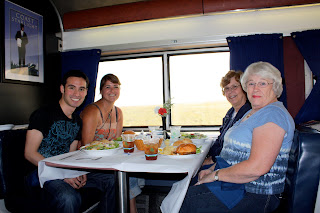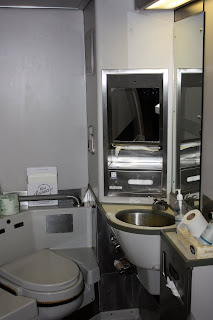America by Train
This summer, I will be traveling all over the United States...by train. Follow me as I go through over 30 states, and hundreds of cities.
Wednesday, September 1, 2010
And it's over
Love,
Pierre~
Tuesday, August 31, 2010
What does the train look like from the inside?

A typical dinning car.

Dining in the train
The following pictures are those of a parlor car from the 1950s. It turns out that the Amtrak Pacific Surfliner, according to some staff members, is the most lucrative route for Amtrak. As a result, the company has added a parlor car from the 1950s for first class passengers only.

This movie theater (below) is also from the 1950's (it is located beneath the parlor). I heard an announcer say that passengers could go to the theater to watch a movie. It turns out the invitation was only for first class.


The Arcade, another feature that is only found in the Surfliner

Coach (above)

The observatory (above) where people congregate to watch the scenery go by

Another lounge/dinning area

A typical bathroom (looks much cleaner in this picture)
Saturday, August 28, 2010
Chicago

I spent a good portion of my day walking around the city, especially around Navy Pier, which provides a wonderful view of Chicago (besides, I am fond of waterfronts). The Sears Tower was a nice building from the outside, but not my favorite building from among the many. Which are my favorites, then?





Cool Fountain:

I think this is a pretty cool landmark of Chicago. The fountain is located nest to a park, and it displays faces of people who pass by. I saw many families with children playing around
Thursday, August 26, 2010
From Chicago to New York
What an unpleasant ride! The staff was overall unfriendly and inefficient. Having being assigned four cars to take care of, the attendant was clearly overworked, and in no mood to provide a friendly service. As soon as passengers boarded the train in Chicago, he passed timetables. “Ladies and gentlemen, all the questions you got can be answered with the information in that pamphlet. Please read this before you ask me any questions. If I can’t answer a question, there’s a number you can call, or a map online you can check,” he instructed. A map online? Maybe he was riding a different train, but Amtrak doesn’t have Internet. As for the number we could call, that would be a wonderful idea if only we had service for more than segments of the trip. After talking to other passengers, I realized I was not the only one having a difficulty swallowing our attendant’s temperament. “This guy shouldn’t be working here,” one lady complained, “He has no understanding of customer service.”
As if the attitude of our attendant weren’t enough, the air conditioning kept the cars at a gelid temperature. Several people approached the staff to ask whether the AC could be turned down a bit. One of the assistant conductor was kind enough to explain that “these cars are so old that they only have an on and off switch. If it’s on, it’s on, and it gets cold, but I’ll see what I can do.” The previous time someone asked for the temperature to be turned down, our attendant just said, “No! There’s nothing I can do,” and continued walking.
Food and Alcohol on the Train
The trains with the dining cars provide breakfast, lunch, and dinner. One has to make reservations for lunch and dinner, though one attendant assured me that one never makes reservations for lunch. Dining dynamics, therefore, vary depending on the train. The dining car features community sitting, meaning the attendants will group strangers at the same table. And while most passengers welcome the excitement of meeting new people, a few others repudiate it by bringing a book to read, carrying an I-pad to send e-mails, or simply remaining quiet during the entire meal.
Breakfast and lunch are rationally priced, with meals costing between $7 and $12. For the price, the food is actually really good, though some passengers have commented that the quality of food vacillates with the party that is in office—“if Republicans are in the White House,” one passenger joked, “we get microwave food. With the Democrats, we get more gourmet.” Dinner seems to me a bit overpriced, with meals costing between fourteen and twenty-two dollars. I do not suggest the steak, which happens to be the most highly priced.
The food in the lounge car is definitely overpriced. A Snickers bar costs two dollars, and a personal microwaved pizza $5.50! If the ride is long, I suggest bringing your own food in a cooler. Amtrak allows the consumption of alcoholic beverages, but you must buy the drinks from the lounge, which can become rather costly. Although it is illegal to bring your own alcohol, many passengers do it anyway. What happens if you get caught? It depends on the conductor—some may throw you out, but most will just take it up. I have come across some passengers who have devised a clever way not to get caught. One gal had bought mini orange juice bottles, and mixed the juice with Vodka. Another guy simply replaced Vodka for water, and drank it straight.
Bottom line: food, for the most part, is overpriced. However, you pay for the experience of dining with others on the train.
Wednesday, August 25, 2010
Interesting Characters
As I have mentioned briefly on a previous entry, I saw a woman who had taken off her wig and placed it next to her on a little stand (not a head, but a little red box). She slept comfortably while the wig greeted the passengers who passed by her seat and looked twice before moving on. By now I have been on some crowded trains, and I have even been woken up so that a person could sit next to me. I wonder how one asks the wig lady to move her wig so that another passenger may take a seat.
Other "interesting" people? Two days ago, a mother let her child go to the bathroom barefooted. That's correct; the kid had no shoes or socks, and he simply strolled to the filthy car bathroom. Note to parents: the train isn't the cleanest place...
Border Patrol
The second time, Border Patrol boarded the train in Buffalo, and one by one asked the passengers, "Are you a citizen?" If the person said 'yes', the agents moved on; if the person said 'no' the agents asked for documentation. The method seemed inefficient. Why would any person living in the US illegally say, "No, I am not a citizen"? An undocumented migrant could answer 'yes' without fear of lying because the question is vague. One lady who was asked whether she was a citizen responded, "You mean of this country? I better be a citizen!" Sure, this response caused laughter, but it points to the need for officers to ask whether people are citizens of the United States, and not just citizens in general.